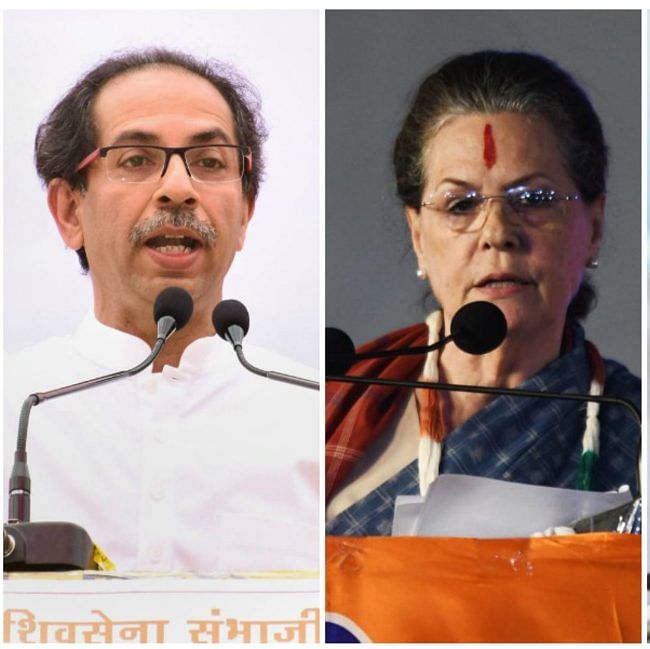
The Congress’s willingness to prop up a Shiv Sena-led government in Maharashtra and its failure to execute the plan, paving way for President’s Rule has once again underlined the party’s failure in taking quick decisions at critical junctures.
The slow reflexes in Maharashtra have also exposed the Grand Old Party’s ineptitude at ‘ideological balancing’ in the changed political ecosystem managed and controlled by right-wing players. Fear factor and getting sucked into a ‘secular image trap’ have also constricted the party leadership’s ability to take bold and out-of-the-box decisions.
By the time the Congress overcame its initial aversion to sup with the Shiv Sena, the Bharatiya Janata Party (BJP) duopoly — PM Narendra Modi and home minister Amit Shah — struck fast and got Central rule clamped in the state, thus aborting a possible Shiv Sena-Nationalist Congress Party-Congress coalition government.
The coming days are pregnant with several possibilities – the Sena-NCP-Congress forming a government; the BJP wooing back the Sena or getting NCP support; or BJP splitting any of the three parties to manufacture majority and forming its government or the state facing another election.
As of now, the Congress’ bloc of 44 MLAs, vocal supporters of Sena-NCP-Congress government, is most vulnerable to a split as most of these legislators do not want to face another election.
As usual, the Congress was divided over joining a Sena-led coalition. Party veteran and a key advisor of the Gandhi family, A K Antony, who is known in party circles by the sobriquet of “Saint Antony” for his clean politics, was ideologically opposed to any truck with Sena, a hardcore Hindutva party. So was K C Venugopal, AICC general secretary (organisation) and sons-of-the soil Shivraj Patil (former Lok Sabha Speaker) Mukul Wasnik, a former union minister.
Politics is the art of managing contradictions, a truism that has been the BJP’s hallmark while fear factor and obsession with its traditional image has been holding the Congress back. Congress should learn the art of nuanced ideological tweaking from secular parties such as the Janata Dal (United), Trinamool Congress, Telangana Rashtra Samithi, Janata Dal (Secular), Dravida Munnetra Kazhagam and YSR Congress who have from time-to-time hobnobbed with the BJP without losing minority votes. And in terms of blatant communal politics, the Sena is better than the BJP.
Some Congress leaders worry that if Sena-NCP-Congress coalition formed its government, the Opposition space in Maharashtra will go to the BJP and that is not good for the party. But others feel the party should do everything to scuttle a BJP-led government. Without electoral success, Congress is in danger of a complete wipe out. These leaders feel that a government in Maharashtra will give psychological advantage to the Congress and have a ripple effect in Karnataka and Haryana, where the BJP is struggling hard to sustain its governments with thin margins, and for the upcoming elections in Jharkhand where allies are dumping the BJP.
On the other hand, if the BJP forms its government in Maharashtra, the immediate casualty could be the Congress bloc and the possibility of the JD(S) changing its equation with the Saffron party in Karnataka.
Party insiders say that post “Modified” BJP, it is not business as usual and that Antony’s political instincts have not stood the test of time. Leaders like Venugopal, Patil and Wasnik are not considered political sharks either. Finally, Congress president Sonia Gandhi took a calculated political risk in going with Sena. But Congress’s ideological confusion and Sena taking almost 20 days to quit NDA wasted considerable time providing BJP the opportunity to press for Central rule. Congress should have learned some lessons from its Goa experience in 2017 and drawn up plans B and C and acted post-haste to thwart President’s rule.
Interestingly, it was Antony himself who had in 2014 suggested that one of the main reasons for the party’s electoral rout was its inability to counter the charge of “minority appeasement”. What he left unsaid was that in a country of 80 per cent Hindus, Congress needs to play soft Hindutva.
Over the last six years, from the moment Modi was projected as the BJP’s prime ministerial candidate in January 2014, the Congress has been wallowing in ideological confusion and that muddle was reflected in its Maharashtra strategy as well. Compounding the ideological perplexity, the party seems to be not able to decide whether or not to target Modi’s persona and his presidential style of politicking.
It is high time the Congress ends its ideological confusion and does smart politics.
(Kay Benedict is a New Delhi-based independent journalist)
Disclaimer: The views expressed above are the author’s own. They do not necessarily reflect the views of DH.